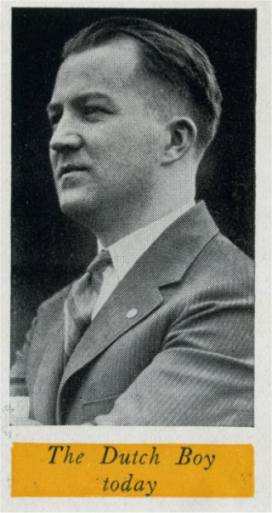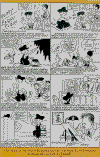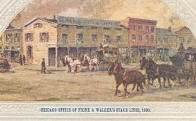
THE original Dutch Boy Painter
was a New Jersey Irish boy. Today twenty-four years after the Dutch Boy
portrait was made, the original model is discovered in a pent house on top
of the Brooklyn Daily Eagle building. Today he does not pose with a paint
brush, keg and wooden shoes. Instead he sits over a drawing board sketching
and painting. He may be drawing a newspaper cartoon that ridicules a passing
fad or presents the gist of an international struggle. He may be creating a
comic strip of a duck performing antics no bird ever dreamed, or it may be
boys playing as all boys play. And the expression on his face reminds one of
the expression of the Dutch Boy, a combination of mischievousness and
seriousness of purpose that has won such affection for the famous trademark
throughout the country.
One day in 1907 young Michael
Brady was playing near his home in Montclair, when Lawrence Carmichael
Earle, noted portrait painter, was passing by. Mr. Earle was thinking of a
new picture he was to paint—a portrait of a Dutch Boy as the trade-mark for
National Lead Company. Perhaps he was thinking also of Gainsborough's "Blue
Boy," to which the picture he planned was later to be compared. Perhaps he
was wondering who could serve as model. However that may be, he saw Michael
and knew that his search for a model was ended. The boy was the right size, his
eyes were the color he wanted, and the boy's face held the painter's fancy.
The details of the posing were
easily arranged. Mr. Earle had access to the studio of his friend, George
Inness, not far from the Brady home. Wooden shoes, blue overalls and cap
were purchased. The boy was told to wear the clothes at play for a few days
so that they would look as if they belonged to him and not like a masquerade
costume.
Never had Michael felt so
important as when he sat on the model stand with the artist before him, busy
at work on a canvas. Never had he seen such a room with an immense skylight
and plaster casts of heads and torsos and hands and feet.
His arm held aloft like the
arm of Liberty grew tired, but there were frequent rest periods when he
could explore the studio room and see how the work on the canvas progressed.
And every day at the end of the posing he received his pay of two dollars an
hour. This, the first money he ever earned, he spent quickly on orgies of
candy and pop. Before the painting was finished the family doctor was called
in to diagnose a strange and painful attack of stomach ache.
From the time he first posed,
Michael had but one ambition. He forgot his former intentions of becoming a
cowboy or a circus acrobat. He was going to make pictures when he grew up.
With Mr. Earle as his hero and a print of the portrait of himself as a
direct incentive, he spent long hours covering sheets of paper and
occasionally fences and walls with his first artistic attempts.
He never lost sight of that
childhood ambition. Today, working for the Brooklyn Eagle, he is one of the
country's powerful cartoonists. With his pictures he influences the tastes
and political thought of thousands of people. With his comics he delights
children and adults in several cities.
The portrait of Mr. Brady as a
boy in overalls and wooden shoes has inspired him to realize a high
ambition. To house painters, decorators and many others, the portrait stands
as a mark of high quality paint products and inspires them with confidence
in work done with those products.

View accompanying cartoon: The story of the boy who posed for the
National Lead Company trade-mark, as told by himself. (Michael Brady,
1931)





